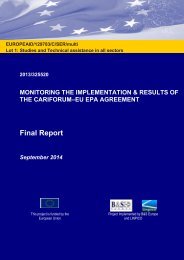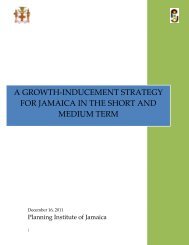Engineers Newsletter
Engineers Newsletter
Engineers Newsletter
Create successful ePaper yourself
Turn your PDF publications into a flip-book with our unique Google optimized e-Paper software.
Alternatively, consider delivering the<br />
conditioned outdoor air directly to each<br />
zone, rather than to the inlet of the fancoils<br />
or heat pumps (Figure 9). In this<br />
case, the local units condition only<br />
recirculated air.<br />
Because the outdoor air is not<br />
distributed through the local fan, that<br />
fan can operate with a two-speed or<br />
variable-speed motor, without<br />
impacting the quantity of outdoor air<br />
delivered to the zone.<br />
This “direct-to-the-zone” approach also<br />
affords the opportunity to deliver the<br />
outdoor air at a cold temperature,<br />
rather than reheated to neutral. This<br />
has several installed cost and energysaving<br />
benefits. 4,5<br />
CO2-based DCV. Single-zone VAV<br />
systems are often used for densely<br />
occupied zones with varying<br />
population. This typically makes them<br />
good candidates for using CO2-based<br />
demand-controlled ventilation (DCV).<br />
With this approach, a sensor measures<br />
the concentration of CO2 in the zone,<br />
and this concentration is then used by<br />
the controller to reset outdoor airflow<br />
as population changes. This saves<br />
energy by not over-ventilating the zone<br />
during periods of partial occupancy.<br />
While Standard 62.1 allows the use of<br />
DCV, it also includes a few<br />
requirements to make it work: 3<br />
“The breathing zone outdoor airflow<br />
shall be reset in response to current<br />
occupancy and shall be no less than the<br />
building component (Ra × Az) of the<br />
zone.” (Section 6.2.7.1.2)<br />
“Systems shall be operated such that<br />
spaces are ventilated in accordance<br />
with Section 6 when they are expected<br />
to be occupied.” (Section 8.3)<br />
While the people component of the<br />
ventilation rate (Rp × Pz) can be varied,<br />
Standard 62.1 states that the controller<br />
cannot reduce outdoor airflow any<br />
lower than the building component of<br />
the ventilation rate (Ra × Az) for that<br />
zone.<br />
Section 8.3 clarifies that this applies<br />
whenever that zone is “expected” to<br />
be occupied. That is, the standard is<br />
not requiring this building component<br />
of the ventilation rate to be delivered to<br />
the zone 24 hours a day, 7 days a<br />
week. Rather, it only requires this<br />
during the normally scheduled<br />
occupied period.<br />
Because the mixing box pressure<br />
varies as supply airflow changes<br />
(Figure 5), DCV must be combined<br />
with either proportional damper control<br />
or a flow-measuring damper in order to<br />
prevent outdoor airflow from dropping<br />
below this minimum threshold.<br />
A previous EN and the Standard 62.1<br />
User’s Manual both describe a<br />
proportional control sequence that can<br />
be used to implement DCV in a singlezone<br />
system. 6,7<br />
Potential Benefits of<br />
SZVAV<br />
Compared to a constant-volume<br />
system, typical benefits of single-zone<br />
VAV include lower energy use, better<br />
dehumidification at part load, and less<br />
fan-generated noise at reduced<br />
speeds.<br />
Lower energy use. Compared to a<br />
constant-volume system, a single-zone<br />
VAV system can result in significant fan<br />
energy savings at part-load conditions.<br />
Figure 10 shows the potential energy<br />
savings of using two-speed or variablespeed<br />
fan control in an example singlestory<br />
K-12 school. TRACE 700 was<br />
used to model the building with a<br />
packaged rooftop unit serving each<br />
zone. 8 The baseline building uses<br />
conventional, constant-volume<br />
rooftops.<br />
Figure 8. Conditioned OA delivered to<br />
inlet of each local unit<br />
For this example, two-speed fan<br />
control (constant fan speed when<br />
heating) reduced HVAC energy use by<br />
about 25 percent, while variable-speed<br />
fan control (capable of variable fan<br />
speed when heating) reduced HVAC<br />
energy use by about 30 percent.<br />
Of course, the impact of two-speed or<br />
variable-speed fan control on the<br />
energy use of a specific building<br />
depends on climate, building layout,<br />
and operating hours. For this example,<br />
high internal loads in the classrooms<br />
resulted in systems operating in<br />
cooling mode for most occupied hours<br />
(even in Minneapolis). Operation of the<br />
heater was mostly limited to morning<br />
warm-up mode.<br />
6 Trane <strong>Engineers</strong> <strong>Newsletter</strong> volume 42-2 providing insights for today’s HVAC system designer<br />
OA<br />
CA<br />
SA<br />
RA<br />
WSHP or<br />
fan-coil<br />
CA<br />
Figure 9. Conditioned OA delivered to<br />
directly to each zone<br />
OA<br />
SA<br />
RA<br />
WSHP or<br />
fan-coil<br />
CA<br />
dedicated OA<br />
unit<br />
Pressure-independent VAV terminals<br />
maintain constant outdoor airflow,<br />
regardless of local fan speed.<br />
RA<br />
CA CA<br />
CA<br />
dedicated OA<br />
unit<br />
Local fans can operate with<br />
two-speed or variable-speed control,<br />
without impacting outdoor airflow.<br />
RA<br />
SA<br />
SA






